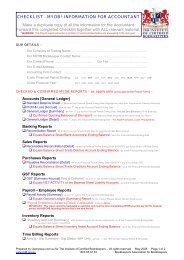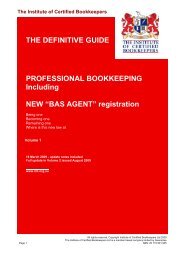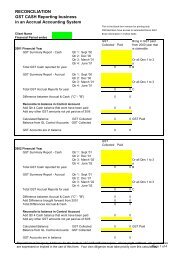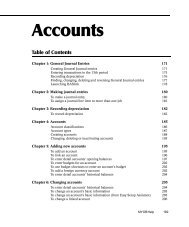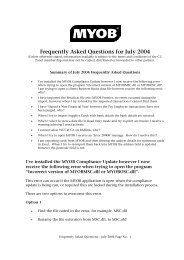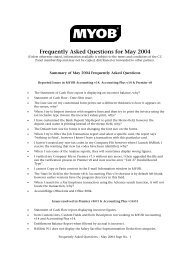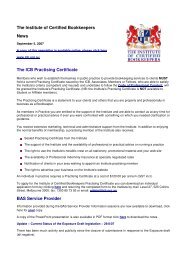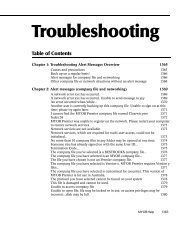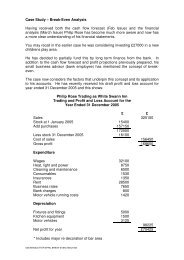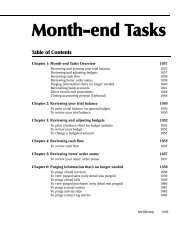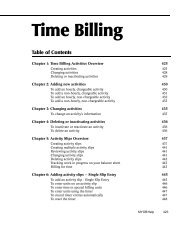You also want an ePaper? Increase the reach of your titles
YUMPU automatically turns print PDFs into web optimized ePapers that Google loves.
<strong>Glossary</strong> <strong>of</strong> <strong>Terms</strong><strong>MYOB</strong> AustraliaBalance Sheet - The balance sheet is a financial “snapshot” <strong>of</strong> a company’s condition at asingle point in time. A balance sheet contains a listing <strong>of</strong> the company’s asset, liability andequity accounts. It is called a balance sheet because the total value <strong>of</strong> the asset accounts minusthe total value <strong>of</strong> the liability always equals the total <strong>of</strong> the equity accounts.Bill - The written record <strong>of</strong> a supplier’s invoice. <strong>MYOB</strong> handles three types <strong>of</strong> bills and they areitem, service or pr<strong>of</strong>essional. An item purchase order is used to buy things on your items list. Aservice purchase order is used to buy things not on your items list. A Pr<strong>of</strong>essional purchase isfor buying time or service, <strong>of</strong>ten over several days.Budgets - Expected monthly net activity for an account. Budgets are useful for planning for thefuture and analysing actual performance against planned performance.Cash Disbursements - “Money out”. All money entered in Write Cheques, Paid Today(Purchases), Vendor Payments, and Write a Refund Cheque (Settle Returns & Credits) isrecorded as a cash disbursement and entered in the Cash Disbursements journal.Cash Drawer - Where the money is kept between leaving the customers hands and beingdeposited in the bank. Many businesses set up their cash drawer as an asset account (DetailCheque Account).Cash Flow - The net flow <strong>of</strong> money in minus money out over a selected date range.Cash Method (basis) - The opposite <strong>of</strong> the accrual method <strong>of</strong> accounting. The cash methodrecords the sale or purchase <strong>of</strong> goods and services at the time they’re paid for, not whenthey’re delivered.Cash Receipts - “Money in”. All money entered in Receive Money, Paid Today (Sales), ReceivePayments, and Receive Refund Cheque (Settle Returns & Debits) is recorded as a cash receiptand entered in the Cash Receipts journal.Chart <strong>of</strong> Accounts - A listing <strong>of</strong> all your asset, liability, equity, income, and cost <strong>of</strong> sales,expense, other income, and other expense accounts.Cleared - A cheque or deposit is cleared when your bank adjusts your account balance for it.Closed Period - An accounting period in which all entries are completed. <strong>MYOB</strong> does notrequire that you actively close a period. However, in Preferences you can prevent accidentalposting to a closed period.10/01/2003 Page 3 <strong>of</strong> 14
<strong>Glossary</strong> <strong>of</strong> <strong>Terms</strong><strong>MYOB</strong> AustraliaClosed Purchases – Are purchases that have been paid in full.Closed Sales – Are Sales that have been paid in full.Company Information - Found in <strong>MYOB</strong>'s Setup Menu, your company information containsyour company’s name, address, and tax ID’s and information about your company’s fiscalyear.Contra Account – Are an account that normally carries the opposite balance <strong>of</strong> the accounts <strong>of</strong>the same type. Assets for example, normally have a debit balance; a common contra-assetaccount is the accrued depreciation <strong>of</strong> an asset. By using a contra account, you can show acompany a car that’s worth $12,000, by listing the asset at its $15,000 purchase price followedby the -$3,000 balance <strong>of</strong> the accrued depreciation account. Contra accounts can also be usedas suspense accounts.Conversion Month - The month in which you start entering transactions in <strong>MYOB</strong>.Cost: Item - The cost <strong>of</strong> an inventory item. <strong>MYOB</strong> uses average cost. That is, it totals the cost<strong>of</strong> all your purchases for a particular item currently on hand and divides by the number <strong>of</strong> itemson hand.Cost <strong>of</strong> Sales - Sometimes called “cost <strong>of</strong> goods sold” this account type works just like anexpense account. The only difference is where it appears on the pr<strong>of</strong>it & loss statement. Cost<strong>of</strong> Sales accounts appears after your income accounts, but before your expense accounts. Cost<strong>of</strong> Sales is subtracted from your income to produce “gross pr<strong>of</strong>it”. Your expenses aresubtracted from your gross pr<strong>of</strong>it to produce “net pr<strong>of</strong>it”. In <strong>MYOB</strong>, you are not required touse Cost <strong>of</strong> Sales accounts.Credit Amount - On the “right” side <strong>of</strong> the ledger (a debit amount occupies the “left” side). Acredit amount increases the balance <strong>of</strong> accounts with a credit balance and decreases thebalance <strong>of</strong> accounts with a debit balance. Accounts that normally carries a credit balance areliability, equity and income accounts.Credit Invoice - In <strong>MYOB</strong> a credit invoice is a sale with a negative balance due. Usually causedby a return or adjustment, a credit invoice is settled by using Settle Returns & Credits. Thereyou can write the customer a refund cheque or apply the amount to another open receivable.Credit <strong>Terms</strong> - <strong>Terms</strong> are the agreed upon rules, governing the number <strong>of</strong> days betweendelivery and payment, discounts for early payment and penalties for late payment. In <strong>MYOB</strong>,10/01/2003 Page 4 <strong>of</strong> 14
<strong>Glossary</strong> <strong>of</strong> <strong>Terms</strong><strong>MYOB</strong> Australiayou can set default terms for all customers when entering your linked receivables accounts inSetup <strong>MYOB</strong> Enter the default terms for your vendors when you enter your linked payablesaccounts. You can override the default terms in each individual card.Creditors - A creditor is someone to whom you owe money. Creditors are <strong>of</strong>ten used instead<strong>of</strong> Payables (see Payables).Current Assets - Assets that can be turned into cash within a relatively short period <strong>of</strong> time(less than a year, are called current assets. Some <strong>of</strong> your current assets are your cheque andsavings accounts, accounts receivable and petty cash. Current assets usually do not lose theirvalue over time. Current assets normally have a debit balance. As a general rule, the morecurrent an asset is, the closer it is to the beginning <strong>of</strong> your chart <strong>of</strong> accounts.Current Liabilities - Liabilities that become payable within the next year are called currentliabilities. When recording a liability that is to be paid back over the next few years, manyaccountants split it into two liabilities. The part that is to be paid <strong>of</strong>f within the next year isentered as a current liability; the remaining is entered as a separate “long-term liability”.Current Year Earnings - Current year earnings is an equity type account. Its balance equalsyour income minus cost <strong>of</strong> sales and expenses. Current year earnings are zero at the beginning<strong>of</strong> a fiscal year. Current year earnings are kept as a running total, as the fiscal (financial) yearprogresses. When you start a new fiscal year, current year earnings are reset to zero by movingits balance into the account called Retained Earnings.Customer - Someone to whom you sell goods or services. In <strong>MYOB</strong> you must enter acustomer card before you can track a receivable balance.Debit - On the “left” side <strong>of</strong> the ledger (the credit amount occupies the “right” side); a debitamount increases the balance <strong>of</strong> accounts with a debit balance and decreases the balance <strong>of</strong>accounts with a credit balance. Accounts that normally carry a debit balance are assets andexpense accounts.Debit Purchase - In <strong>MYOB</strong> a debit purchase is a purchase with a negative balance due. Usuallycaused by a return or adjustment, a debit purchase is settled by using Settle Returns & Debits.There you can deposit a vendor’s refund cheque or apply the amount to another open payable.Debtors - A debtor is someone who owes you money. The word Debtors is <strong>of</strong>ten used instead<strong>of</strong> Receivables (see Receivables).10/01/2003 Page 5 <strong>of</strong> 14
<strong>Glossary</strong> <strong>of</strong> <strong>Terms</strong><strong>MYOB</strong> AustraliaDeposits: From Customers - Advances received for goods or services not yet delivered.Customer deposits are kept in a liability type account. When a customer makes a paymentagainst a pending sale, <strong>MYOB</strong> treats it as a deposit.Deposits: To Supplier's - Advances paid to Supplier's for goods or services not yet delivered.Vendor deposits are kept in an asset type account.Depreciation - The expense allocation <strong>of</strong> the cost <strong>of</strong> an asset over a period <strong>of</strong> time. Mostaccountants create a contra-asset account to track the depreciation <strong>of</strong> an asset. See ContraAccount. A typical depreciation transaction credits the contra asset account and debits adepreciation expense account. Depreciation is most <strong>of</strong>ten recorded as a general journal entry.Detail Accounts - An <strong>MYOB</strong> account to which transactions can be assigned.Disbursements: Cash - “Money out”. All money entered in Spend Money, Paid Today(Purchases), Pay Bills, and Pay Refund (Settle Returns & Credits) is recorded as a cashdisbursement and entered in the Cash Disbursements journal.Discount: Early Payment - The amount taken <strong>of</strong>f the balance due in return for payment withinan agreed upon number <strong>of</strong> days.Discount: Volume Purchase - The amount taken <strong>of</strong>f an item’s cost because <strong>of</strong> a special vendoror customer arrangement.Discount Days – Discount Days are the number <strong>of</strong> days from a sale or purchase, within whichfull payment <strong>of</strong> the balance due entities the payee to a discount.Double Entry <strong>Accounting</strong> - A method <strong>of</strong> bookkeeping in which every entry is balanced byanother entry. Correct double-entry accounting always provides a balanced set <strong>of</strong> books; thatis, the total value <strong>of</strong> your asset accounts minus the total <strong>of</strong> your liability accounts will equal thetotal <strong>of</strong> your equity accounts.E&OE - Errors and Omissions Excepted. A note <strong>of</strong>ten found on financial documents indicatingthat errors may be corrected if found.Earnings - Income minus cost <strong>of</strong> sales and expenses. See Current Year Earnings.10/01/2003 Page 6 <strong>of</strong> 14
<strong>Glossary</strong> <strong>of</strong> <strong>Terms</strong><strong>MYOB</strong> AustraliaEquity - A company’s “net worth”. The equity portion <strong>of</strong> a company equals its assets minus itsliabilities. Equity is an account type in <strong>MYOB</strong> It usually carries a credit balance. Some commonequity accounts are current year earnings, retained earnings and shareholder’s equity.Expense - The cost associated with running a business. Expense is an account type in <strong>MYOB</strong>. Itusually carries a debit balance.Finance Charge - The amount added to an outstanding balance as a penalty for late payment.Financial Statements - The balance sheet and income (pr<strong>of</strong>it & loss) statement. The balancesheet is your company’s financial picture at a single point in time. The income statementshows your company’s financial performance over a period <strong>of</strong> time.Fiscal Year – Financial Year - The 12- month period you use to define your accounting year.<strong>MYOB</strong> does not require that it match the calendar year. <strong>MYOB</strong> also provides an optional 13thperiod for making year-end adjustments that you do not want to affect a particular month.Fixed Assets – Fixed Assets are assets, which have a relatively long life. Your buildings, carsand computers are fixed assets. Fixed assets are usually depreciated; that is, they lose some <strong>of</strong>their value as you use them.General Journal - A journal is a helpful organising tool. It ties like transactions together forease <strong>of</strong> access. In <strong>MYOB</strong> the general journal keeps transactions that do not belong in the Sales,Purchases, and Inventory, Cash Disbursements, or Cash Receipts journals.General Ledger - This is where all your account information -sales, purchases, inventory, cashin, cash out - come together. You draw your financial statements - balance sheet and incomestatement - from the general ledger.Gross Pr<strong>of</strong>it - Gross pr<strong>of</strong>it is your income minus cost <strong>of</strong> sales.Header Account - A header account in <strong>MYOB</strong> is used to group other accounts together forreporting clarity. You may not post a transaction to a header account.Historical Balance – Is the balance <strong>of</strong> an account prior to converting your records to <strong>MYOB</strong>.You are not required to enter historical balances in <strong>MYOB</strong> Enter them only if you wish tocompare a current month’s activity to the activity for the same month last year. Clicking abutton at the bottom <strong>of</strong> the Chart <strong>of</strong> Accounts window enters Historical Balances.10/01/2003 Page 7 <strong>of</strong> 14
<strong>Glossary</strong> <strong>of</strong> <strong>Terms</strong><strong>MYOB</strong> AustraliaHistorical Purchase - A purchase made prior to using the Purchases command centre in <strong>MYOB</strong>requires that you enter historical purchases that make up the current balance <strong>of</strong> the linkedaccount, however, you may do this at anytime and may use the Purchase Command Centrebefore this has been completed.Historical Sales - A sale made prior to using the Sales command centre in <strong>MYOB</strong> requires thatyou enter the historical sales that make up the current balance <strong>of</strong> the linked receivablesaccount, however, you may do this at anytime and may use the Sales Command Centre beforethis has been completed.Identifiers - A one-letter code used to sort and select cards in the card file. <strong>MYOB</strong> lets youassign up to 26 identifiers to a card.Income - Revenue from the sale <strong>of</strong> goods or services. Income is an account type in <strong>MYOB</strong>. Itusually carries a credit balance.Income Statement - Also called a “pr<strong>of</strong>it & loss” statement, the income statement shows yourcompany’s performance over a period <strong>of</strong> time. A <strong>MYOB</strong> Income statement begins withincome. It then subtracts cost <strong>of</strong> sales to produce a gross pr<strong>of</strong>it. Expenses are subtracted fromgross pr<strong>of</strong>it to produce operating pr<strong>of</strong>it. “Other income” accounts are added to operatingpr<strong>of</strong>it and “other expense” accounts are subtracted form operating pr<strong>of</strong>it to produce net pr<strong>of</strong>it.Inquiry - A menu provided by <strong>MYOB</strong> to facilitate searching for a transaction. Inquiry displaysare for searching only, they should not be confused with trial balance, receivables or payablesreports.Inventory - Physical items kept for possible sale to a customer. Most accountants record aninventory’s value in a current asset account.Invoice - The written record <strong>of</strong> a sale. <strong>MYOB</strong> handles 4 types <strong>of</strong> invoices: item, service orpr<strong>of</strong>essional and other. An item invoice is used to sell things on your items list. A serviceinvoice is used to sell things that are not on your items list. A pr<strong>of</strong>essional invoice is for billingwork done, <strong>of</strong>ten over several days.Item - A unit in <strong>MYOB</strong>’s items list. An item can be physical inventory, like a widget or a pair <strong>of</strong>shoes, or it can be non-physical like an hour <strong>of</strong> your time.Item Invoice – Is the written record <strong>of</strong> a sale <strong>of</strong> something on <strong>MYOB</strong>’s items list.10/01/2003 Page 8 <strong>of</strong> 14
<strong>Glossary</strong> <strong>of</strong> <strong>Terms</strong><strong>MYOB</strong> AustraliaItem Purchase Order - The written record <strong>of</strong> a purchase <strong>of</strong> something on <strong>MYOB</strong>’s items list.Job – Job is something for which you wish to track income and expenses. In <strong>MYOB</strong>, a job canbe a pr<strong>of</strong>it centre, a product line or any other subset <strong>of</strong> your business that requires a separateincome statement.Journal - A journal is a tool for organising your accounting entries. <strong>MYOB</strong> groups all entriesinto one <strong>of</strong> six journals: General, Disbursements, Receipts, Sales, Purchases, or Inventory. Ajournal is simply a helpful organising tool - nothing more or less.Liability - Liabilities are things you owe. You working capital loan is a liability. Your accountspayable, what you owe someone for a purchase, is also a liability. Liabilities that are due withinthe next year are called “current liabilities”. When a liability is not due for more than a year, itis called a “long term liability”. Liabilities normally have a credit balance.Linked Account - Linked accounts are what <strong>MYOB</strong> uses to post your inventory, sales andpurchase transactions to the proper account. When, for example, you link your receivablesaccount, you are telling <strong>MYOB</strong> which account to post the balance due from a sale. You linkyour receivables and payables accounts from the Setup Menu in <strong>MYOB</strong>. From then on, youcan use <strong>MYOB</strong>’s invoice and purchase order functions without having to identify them everytime.Long-Term Liability - Something you owe that does not have to be paid for at least a year.Net Income – Net Income (Net Pr<strong>of</strong>it /Loss) the total <strong>of</strong> all income accounts minus the sum <strong>of</strong>your expense and cost <strong>of</strong> sales accounts.Net Pr<strong>of</strong>it (Loss) - The total <strong>of</strong> all income accounts minus the sum <strong>of</strong> your expense and cost <strong>of</strong>sales accounts. Also called “Net Income”Open Bill - A purchase with an outstanding balance due.Open Sale - A sale with an outstanding balance due.10/01/2003 Page 9 <strong>of</strong> 14
<strong>Glossary</strong> <strong>of</strong> <strong>Terms</strong><strong>MYOB</strong> AustraliaOpening Balance - The dollar value <strong>of</strong> an account as <strong>of</strong> your the point in time you startedusing <strong>MYOB</strong> (Conversion Month) <strong>MYOB</strong> Opening balances are entered from <strong>MYOB</strong>'s Setupmenu. They must balance - total assets must equal the total <strong>of</strong> liabilities plus equity - however,<strong>MYOB</strong> will allow you to continue without completing this information by balancing for you,using the Historical Balancing equity account. When you know the full information, you canenter the missing balances and <strong>MYOB</strong> will automatically remove the Historical Balancing figure.Operating Pr<strong>of</strong>it – Is your pr<strong>of</strong>it before considering account types “other income” and “otherexpense”.Other Expenses - A <strong>MYOB</strong> account type used to record expenses that are not directly relatedto your company’s operations. Use other expense accounts to record expenses that are outsidethe normal operation <strong>of</strong> your business such as loan interest, fines, etc. Then you look at yourP&L (Pr<strong>of</strong>it & Loss), <strong>MYOB</strong> removes these costs from the operating costs and gives you aclearer picture <strong>of</strong> your operations. Other expense accounts usually have a debit balance.Other Income - A <strong>MYOB</strong> account type used to record income that is not directly related toyour company’s operations. Use other income accounts to record income that is outside thenormal operation <strong>of</strong> your business such as interest income. When you look at your P&L (Pr<strong>of</strong>it& Loss), <strong>MYOB</strong> removes the income from your operating income and gives you a clearerpicture <strong>of</strong> your operations. Other income accounts usually have a credit balance.Other Purchases – Other Purchase are used in <strong>MYOB</strong> to record non-item purchases that donot require a printed purchase order.Other Sales - Used in <strong>MYOB</strong> to record non-items sales that does not require a printed invoice.Out <strong>of</strong> Balance - When the total credit amount does not equal the total debit amount in atransaction, it is out <strong>of</strong> balance. <strong>MYOB</strong> does not allow you to record an out <strong>of</strong> balancetransaction.Paid up Capital – Is the amount <strong>of</strong> money paid by shareholders in excess <strong>of</strong> the par value <strong>of</strong>the share.Par Value - The face value <strong>of</strong> a share in a company. Most times it has very little to do with theactual value <strong>of</strong> the share.10/01/2003 Page 10 <strong>of</strong> 14
<strong>Glossary</strong> <strong>of</strong> <strong>Terms</strong><strong>MYOB</strong> AustraliaPayables - What you owe someone else for items or services delivered. In <strong>MYOB</strong> accountspayable is a liability account. Any time you record a purchase in the Purchases commandcentre, the unpaid balance <strong>of</strong> the purchase is added to your accounts payable. Every time youpay a bill (using Pay Bill in the Purchases command centre); the amount is subtracted fromyour accounts payable balance.Purchase Order - In <strong>MYOB</strong>, when you make a purchase but have not yet received the goodsor services, you can enter a pending purchase. A pending purchase does not record thepurchase, nor does it increment your inventory. It simply keeps the purchase on file to berecorded when the goods or services are delivered. A payment applied to a pending purchaseis treated as a deposit.Point <strong>of</strong> Sale System - Entering and printing invoices as they are made to the customer. InPreferences there is a checkbox for printing invoices as they are recorded.Prepaid Expenses - Something you pay for (usually a service) in advance <strong>of</strong> receiving it.Prepaid expenses are assets. A good example <strong>of</strong> a prepaid expense is your insurance payment.Say your insurance costs are $100 per month. At the beginning <strong>of</strong> the year, you pay $1,200for a year’s insurance. The $1,200 is a prepaid expense and is recorded as an asset. Everymonth, as you “use up” your insurance, you need to move $100 from the prepaid expenseasset account to your insurance expense account.Pr<strong>of</strong>essional Invoice – Is the written record <strong>of</strong> a sale <strong>of</strong> time or service, with the facility torecord the dates <strong>of</strong> each service.Pr<strong>of</strong>essional Purchase - As above but 'record <strong>of</strong> a purchase'.Primary Vendor - In <strong>MYOB</strong> the primary vendor is the vendor from which you usually purchasea particular item. When your To Do List says that you’re running low on an item, if the itemhas a primary vendor, click the arrow and <strong>MYOB</strong> automatically creates a purchase order.Pr<strong>of</strong>it takes a few forms: The total <strong>of</strong> all income accounts minus your cost <strong>of</strong> sales is calledyour “gross pr<strong>of</strong>it”. The total <strong>of</strong> all income accounts minus your cost <strong>of</strong> sales and yourexpense is called your “operating pr<strong>of</strong>it”. When you subtract other expenses and add otherincome to operating pr<strong>of</strong>it you have “net pr<strong>of</strong>it”.10/01/2003 Page 11 <strong>of</strong> 14
<strong>Glossary</strong> <strong>of</strong> <strong>Terms</strong><strong>MYOB</strong> AustraliaPr<strong>of</strong>it & Loss Statement - Also called an “income statement” shows your company’sperformance over a period <strong>of</strong> time. An <strong>MYOB</strong> pr<strong>of</strong>it & loss statement begins with income. Itthen subtracts cost <strong>of</strong> sales to produce a gross pr<strong>of</strong>it. Expenses are subtracted from gross pr<strong>of</strong>itto produce operating pr<strong>of</strong>it. “Other income” accounts are added to operating pr<strong>of</strong>it and“other expense” accounts are subtracted from operating pr<strong>of</strong>it to produce net pr<strong>of</strong>it.Pr<strong>of</strong>it Centre - A subset <strong>of</strong> your business for which you want to track income and expenses.<strong>MYOB</strong> calls pr<strong>of</strong>it centres “jobs”.Promised Date - The date a pending sale or pending purchase is due to be delivered. If apending sale is not delivered as <strong>of</strong> its promised date, a reminder is posted to <strong>MYOB</strong>’s To DoList.Purging - The act <strong>of</strong> erasing old data. <strong>MYOB</strong> allows you to purge journal entries, closed sales,closed purchases, and contact logs.Recap Transaction - A <strong>MYOB</strong> function that lets you look at a journal entry before it is recorded.Recap transaction is particularly useful for those transactions, like invoices and bills, for whichthe journal entry is not immediately obvious.Receipts, Cash - “Money In”. All money entered in Receive Money, Paid Today (Sales),Customer Payments, and Deposit a Refund Cheque (Settle Returns & Debits) is recorded as acash receipt and entered in the Cash Receipts Journal.Receivables - What someone else owes you for items or services delivered. In <strong>MYOB</strong>receivables are kept in an asset account. Any time you record a sale in the Sales commandcentre, the unpaid balance <strong>of</strong> the sale is added to your receivables account. Every time youenter a customer payment (using Customer Payments in the Sales command centre); theamount is subtracted from your receivable account.Reconciling - The process <strong>of</strong> checking that your records agree with your bank’s records.Recontact Date - In <strong>MYOB</strong>’s Contact Log the recontact date is the date you promised to getback in touch with a contact (card file entry). Once the recontact is made you should erase therecontact date from the contact log record. Otherwise, it will show up in your To Do List.Recurring Transaction – Is an accounting entry that is made periodically, such as weeklypayroll, monthly rent, etc. <strong>MYOB</strong> allows you to set up recurring cheques, deposits, and generaljournal entries.10/01/2003 Page 12 <strong>of</strong> 14
<strong>Glossary</strong> <strong>of</strong> <strong>Terms</strong><strong>MYOB</strong> AustraliaRetained Earnings - Money from previous year’s earnings that has been left in the company.At the end <strong>of</strong> a fiscal year any money earned (or lost) during the fiscal year is transferred toretained earnings. Retained earnings are an equity account.Revenue - Income from the sale <strong>of</strong> goods or services. Revenue is recorded in an incomeaccount in <strong>MYOB</strong> Income accounts usually carry a credit balance.Reversing - The process <strong>of</strong> counteracting a mistaken transaction by entering a new transactionwith the same amounts, but with opposite signs.Sales History - <strong>MYOB</strong> retains monthly sales figures for an item, customer or salesperson. Check“Track Sales History” in the item or card information window.Sales Order - In <strong>MYOB</strong>, when you make a sale but have not yet delivered the goods orservices, you can enter a pending order. A pending invoice does not record the sale, nor doesit decrement your inventory. It simply keeps the invoice on file to be recorded when the goodsor services are delivered. A payment applied to a pending invoice is treated as a deposit.Shareholder’s Equity - The owner’s stake in the company. It is comprised <strong>of</strong> the amount theowners invested in the company plus the current year earnings and retained earnings.Service Invoice - The written record <strong>of</strong> a sale <strong>of</strong> something not on <strong>MYOB</strong>’s items list.Service Purchase Order - The written record <strong>of</strong> a purchase <strong>of</strong> something not on the item’s list.Settle a Credit Invoice - When someone returns something, and you record an invoice thathas a negative balance due it is called a “credit invoice”. “Paying <strong>of</strong>f” this negative amount iscalled settling a credit invoice. Use Settle Returns & Credits to either write a refund cheque orapply the amount to another open invoice.Settle a Debit Purchase - When you return something to a vendor, and you record a purchasewith a negative balance due it is called a “debit purchase”. “Paying <strong>of</strong>f” this negative amount iscalled settling a debit purchase. Use Settle Returns & Debits to either deposit the vendor’srefund cheque or apply the amount to another open purchase.SME – Small to Medium Enterprises10/01/2003 Page 13 <strong>of</strong> 14
<strong>Glossary</strong> <strong>of</strong> <strong>Terms</strong><strong>MYOB</strong> AustraliaStarts a New Year - After all transactions for a fiscal year have been entered, you must start anew fiscal year. In addition to clearing out your old transactions, starting a New Year movesthe balance <strong>of</strong> current year earnings and resets the balance <strong>of</strong> your income, cost <strong>of</strong> sales, andexpense accounts to zero. <strong>MYOB</strong> allows you to Start a New Payroll Year prior to rolling overthe rest <strong>of</strong> your accounts, to allow you to continue the Payroll section while your accounts arebeing finalised for the year.<strong>Terms</strong> - <strong>Terms</strong> are the agreed upon rules governing the number <strong>of</strong> days between delivery andpayment, discounts for early payment and penalties for late payment. In <strong>MYOB</strong>, you can setdefault terms for all your customers when you enter your linked receivables accounts in theSetup menu. Likewise, you can enter the default terms between you and your vendors whenyou enter your linked payables accounts.Transaction - An entry in <strong>MYOB</strong> that affects an account or accounts.Trial Balance - This is a report showing all the activity for an account or accounts within aselected date range. It shows the balance <strong>of</strong> the account at the beginning <strong>of</strong> the date range,the activity within the date range, and the balance at the end <strong>of</strong> the date range. The trialbalance is a useful tool for checking your entries prior to doing your period-end processing.Supplier - Someone from whom you buy goods or services. In <strong>MYOB</strong> you must enter a suppliercard before you can track a payable balance.Year End – Is the end <strong>of</strong> your fiscal year. It does not necessarily match the end <strong>of</strong> the calendaryear. See Start a New Year.10/01/2003 Page 14 <strong>of</strong> 14



